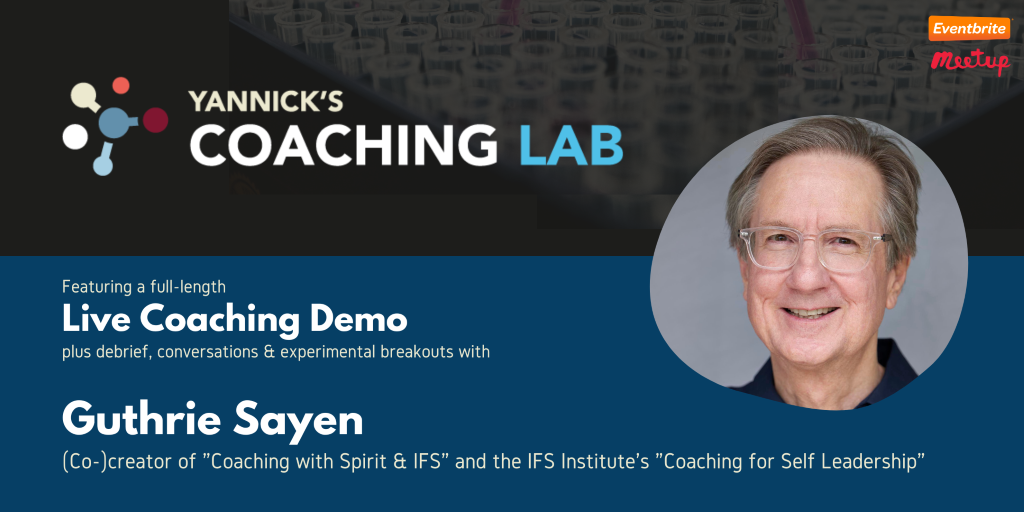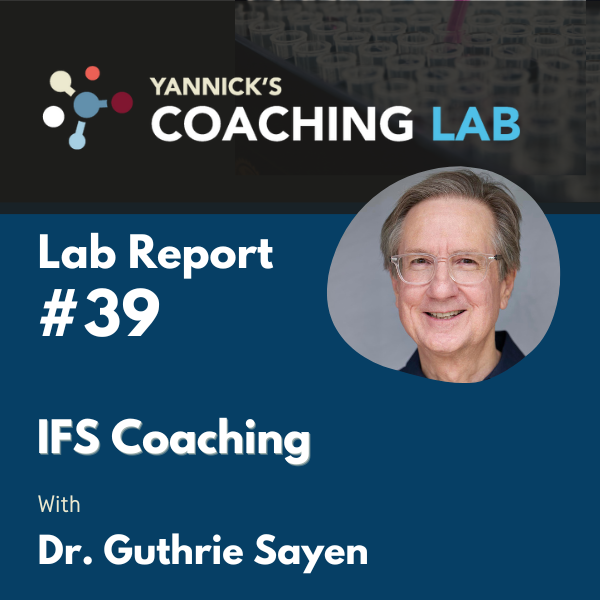
Yannick’s Coaching Lab features guest coaches from a broad variety of approaches, who showcase how they work as part of a live 45min coaching session, followed by reflections and Q&A with the audience.
Curious to know what this session was like? Have a peek at the Lab Report below or consider VIP membership to access the full recording of this and many more exciting sessions.
Yannick’s Coaching Lab #39 — Guthrie Sayen
Lab Report by Natalie Fraser
Summary
Guthrie’s client has been a coach for approximately a year and wants to be more visible”, get out there”, and build his practice, but is facing emotional obstacles. He has come to coaching because he is feeling self-doubt which is getting louder and louder to the point that he is questioning whether he’ll make it as a coach. This fear prevents him from doing things he would like to do. He has worked with the IFS model before. On request of the client, they had a 30min pre-call during which Guthrie introduced himself so that they could build trust and rapport ahead of the session.
During the session, Guthrie facilitated a dialogue between a “younger part that carries the emotion”, several protector parts, and the client’s “Self with a capital S”, which ultimately led to some “releasing”, which made the client feel a lot lighter.
Key Insights
4 agreements
“Safety, privacy, confidentiality, and you can ask me anything.” Guthrie’s contracting was concise and powerful. The client feeling safe was crucial to the work. Guthrie made it clear that it is the client’s choice whether or not they share what they discover, or whether they keep it to themselves. The coach doesn’t need to know the content of the session. A pause was left after each agreement to invite dialogue rather than dictate. These agreements are not IFS-trained but rather how Guthrie keeps demo sessions safe. Allowing the client to “ask anything personal” is to level the playing field by making himself vulnerable.
Settling in
Guthrie invited his client to start the session by joining him in taking a long minute to be silent and become present, to “allow their spirits to connect”.
I’m going to guide you
The foundation for the roles of client and coach were set by Guthrie, explaining that he will assume the role of guiding his client to the parts which need attention. Once the client connects to their Self, the coach can step back and let the client led.
Who needs our attention now?
The client began to share the content of their life that they wanted to share. After collecting enough information Guthrie gently interrupted the content-based dialogue and reflected back what he’d understood in ‘parts language’. Guthrie uses this question after identifying multiple parts to ask the client which part needs their attention now.
Permission Questions – Does anybody have any concerns about going and meeting [this part]?
These questions were asked often throughout the session. They invite the client to communicate with their internal parts and notice any resistance with the objective of his client’s parts providing consent for their world to be explored. No resistance was found by the client, but Guthrie pre-emptively assured the client that if any was, this would be okay and something they could explore together. In the Q&A Guthrie reflected that protector’s did resist at times, for example with the young child, and these lines were respected not pushed through. It was suggested that this could be something to explore in future sessions.
Where do you sense this part in or around your body?
Guthrie connects his client with his embodied experience of the part being explored. In this session, the focused part was experienced by the client as blocking his ability to breathe, leading to a deeper exploration about why the part assumed this role.
How do you feel towards; do you have any judgements towards this part? Ask: how are you trying to help me?
As the client sits with the part being explored, these questions invite a deeper compassion and understanding not only about the part but the client’s relationship with this part. By taking time to notice, the client is able to identify that the part wants them to be happy, that it is heavy, because it is protecting what has been buried for so long – a lack of familial safety, a wish that they had it; a fear of having nowhere to turn if things go wrong; a question of being appreciated; the birth of self-doubt.
Communication between parts
Guthrie expressed that he wanted the client to ask the parts to communicate about what had been buried or what was being protected, and see if they can help and support each other. When the client understood messages from the parts, Guthrie asked the client to convey the message: “Let him know”.
“It’s been a long time” | How old are the parts?
Guthrie invited the client to recognize that not all parts match the client’s current age and explore how old certain parts are. This was also conveyed to the parts. A young part was able to express messages and feelings that Guthrie helped his client acknowledge had been buried for a long time, and invited “Let him cry, for as long as he needs”. At no point during the session was the client rushed to answer or break the silence.
Release/unburdening
By co-identifying what the parts are carrying, Guthrie guided his client to support the parts to release the pain, suffering, and limiting beliefs that were being unnecessarily carried. This is the unburdening level of IFS. Guthrie invited these to be released to the elements, to light, or to ‘anything else’. The client identified that “[the part] wants to just drop it”. Guthrie continues to offer his clients options about how to: all at once? Little by little? Into a box for later? The client’s choice and agency is at the forefront of every intervention Guthrie makes.
Filling The New Space Created
When the part had released and let go of some of it’s emotions and qualities, Guthrie guided his client to ask what qualities the part may like to invite in now that the space was free. “joyfulness, empathy, and a first-aid-kit” filled the space that fear and doubt had once held.
Over the next 30 days
To close the session, Guthrie invited his client to send some appreciation to the protector parts for all the hard work they’ve been doing and checked whether the parts were able to receive this appreciation – which they were. Guthrie asked his client if he would be willing to check in with his parts over the next 30 days.
Can I hold the space myself?
The client was invited to ask Guthrie any questions as the session closed. He asked, “can I hold the space myself?”. Guthrie reflected that “yes, you can” providing examples of how the client had demonstrated accessing their Self (with a capital S) and was already able to supply answers and hold space for his parts within the session. More practice brings more confidence.
Coaching or therapy?
Guthrie invited the audience to expand their idea of what coaching entails. Since the client and their parts are capable to ensure safety, and Guthrie does not push to talk to parts that the client feels uncomfortable talking to, he says that “there is no place I wouldn’t go”. While new coaches may be discouraged from working with “exile parts” such as “the one that holds all the emotions”, guarded by protectors, experienced IFS practitioners tend to feel safe doing this work, and so Guthrie doesn’t draw boundaries between IFS Coaching and IFS Therapy.
Richard “Dick” Schwartz (the IFS founder) describes IFS as a ‘personal development’ model, indicating that it is not bound to a coaching, therapy, social worker, etc profession. The ‘lines’ drawn by associations (e.g. IFS, Association for Coaching, or the IFS Institute) “don’t make sense to me” said Guthrie, who suggests that “if you’re deeply respectful of the client’s protective system, you don’t get into trouble. Your ability and comfort should be your line.”
Key take-aways
Guthrie shares that it’s always important to link the sessions, starting each session by checking in with the parts explored in the previous session.
The coaching begins as soon as the coach and client are together, the energetic connection exists before words are spoken. The contracting is a way to energetically explore how the coach and client’s systems are working together.
“Your client doesn’t need to know IFS” – The coach does, but the client doesn’t need to because the language is accessible and relatable, and can be used more and less discretely.
The client shared the importance of chemistry and of trusting their coach. “Coaches can be masters in their skills, but with a vibe that does not connect”. The safer the client feels, the deeper the work can go.
A single session in a group container can be deeply healing due to the many energetic bodies present.
Bringing in the body and the coach observing the bodily responses contributes to the un-blending of parts and allows the witnessing of the responses of the parts. Dick Schwartz was in collaboration with a somatic experience practitioner at the time IFS was developed, and calls IFS a body-centered approach.
Guthrie’s experience has found that people often experience the same parts in and around their bodies in the same places, for example – the critic is often sensed just behind the right side of the head.
“We are not equal” Guthrie acknowledges the power imbalance of a client paying to see him. By inviting them to ask him personal questions & answering them – especially doing a demo – puts himself at risk when in front of the audience (Leonard Cohen). This can often completely shift the dynamic of the room and enhance the depth of the session.
Watch the recording of this session by joining the Lab as a member: www.GoCoachingLab.com
A list of all available recordings can be found at https://bit.ly/LabRecordings
This Lab Report was authored by Natalie Fraser
Natalie is an existential Counselling Psychologist, specialising in trauma and transformation, and curious about coaching. Interested in exploring life’s Big Questions? Find out more at: www.existentialofferings.com

